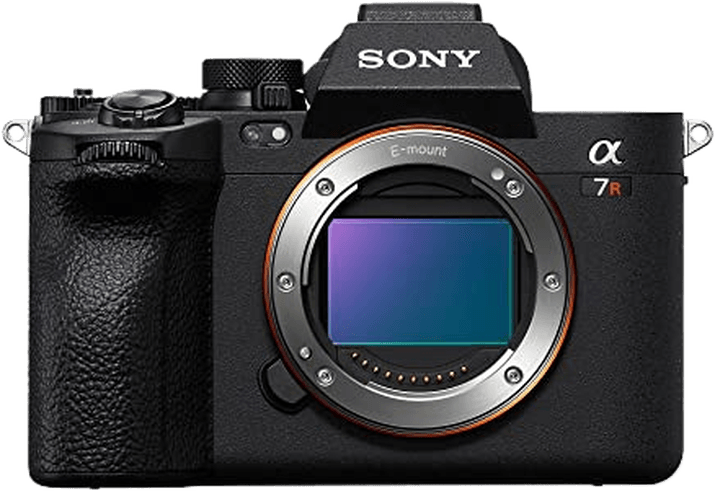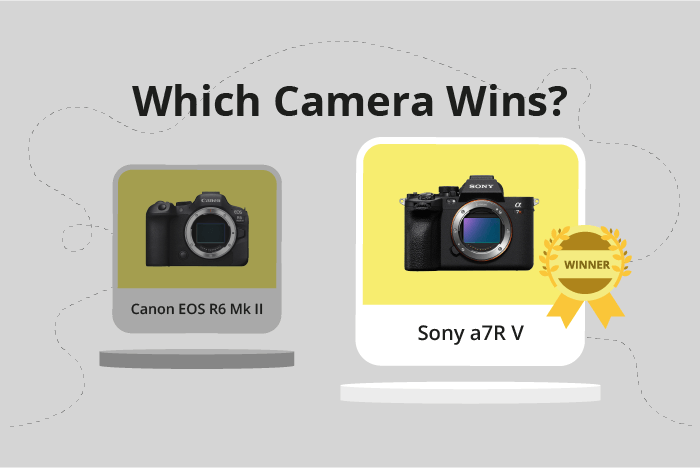Canon EOS R6 Mark II vs Sony a7R V Comparison
Canon EOS R6 Mark II

Sony a7R V

The Sony a7R V outperforms the Canon EOS R6 Mark II with a score of 85/100 compared to 78/100. Both cameras are mirrorless, released in 2022, and have similar dimensions, with the Canon being slightly larger. However, the Canon is lighter, weighing 588g, while the Sony weighs 723g.
The Sony a7R V excels with its higher score, justifying its higher launch price of $3999, compared to the Canon’s $2499. This suggests superior performance in certain aspects. On the other hand, the Canon EOS R6 Mark II might appeal to those seeking a more budget-friendly and lightweight option.
Considering the scores, the Sony a7R V is the better camera. However, the Canon EOS R6 Mark II offers a more affordable and lightweight alternative, making it a suitable choice for specific needs and preferences.
Canon EOS R6 Mark II vs Sony a7R V Overview and Optics
The Sony a7R V wins in the optics comparison with a score of 85/100, while the Canon EOS R6 Mark II scores 83/100. Both cameras share several specifications, such as CMOS sensor type, full-frame sensor size, and image stabilization. Additionally, both cameras have their own lens mounts: Canon RF for the EOS R6 Mark II and Sony FE for the a7R V.
The Sony a7R V outperforms the Canon EOS R6 Mark II with its higher megapixel count of 61, compared to the Canon’s 24 megapixels. This higher megapixel count allows the Sony a7R V to capture more detail and produce higher resolution images. Furthermore, the Sony a7R V also has a higher DXOMARK score for its sensor, 94 compared to the Canon’s 91, indicating better overall image quality.
However, the Canon EOS R6 Mark II has its own advantages, particularly in shooting speed. With a shooting speed of 40, the Canon surpasses the Sony a7R V’s shooting speed of 10. This higher shooting speed enables the Canon EOS R6 Mark II to capture fast-moving subjects more effectively, making it ideal for sports and wildlife photography.
In terms of processors, the Canon EOS R6 Mark II uses the Digic X, while the Sony a7R V uses the Bionz XR. Although both processors are advanced and capable, their specific advantages depend on the user’s preferences and requirements.
Considering these points, the Sony a7R V excels in image resolution and quality, making it a better choice for photographers who prioritize detail and high-quality image capture. On the other hand, the Canon EOS R6 Mark II’s superior shooting speed makes it more suitable for those who need to capture fast-moving subjects.
Canon EOS R6 Mark II vs Sony a7R V Video Performance
The Sony a7R V is the clear winner in video capabilities, scoring a perfect 100/100 compared to the Canon EOS R6 Mark II’s score of 83/100. Both cameras share some common specifications, such as having time-lapse functionality built in, which is a useful feature for creating dynamic and visually appealing videos.
The Sony a7R V outperforms the Canon EOS R6 Mark II in several aspects. Firstly, the Sony a7R V boasts an impressive 8K maximum video resolution, double that of the Canon EOS R6 Mark II’s 4K resolution. This allows the Sony a7R V to capture stunningly detailed and high-quality videos. Additionally, the Sony a7R V has a maximum video dimension of 7680 x 4320, which is significantly larger than the Canon EOS R6 Mark II’s 3840 x 2160. This results in more detailed and visually appealing videos. Lastly, the Sony a7R V has a higher maximum video frame rate of 120fps, compared to the Canon EOS R6 Mark II’s 60fps. This enables the Sony a7R V to capture smoother, more fluid motion in videos.
The Canon EOS R6 Mark II, while not as strong in video specifications as the Sony a7R V, still offers solid video capabilities with its 4K resolution and 60fps video frame rate. These features will satisfy most users’ video needs, especially if they are not looking for the highest possible video quality.
Considering the differences in video capabilities, the Sony a7R V is the superior choice for those seeking top-notch video quality, resolution, and frame rate. The Canon EOS R6 Mark II, on the other hand, remains a good option for users who require solid video performance but do not need the absolute best specifications.
Canon EOS R6 Mark II vs Sony a7R V Features and Benefits
The Sony a7R V outperforms the Canon EOS R6 Mark II in features, scoring 87/100 compared to the Canon’s 72/100. Both cameras share several specifications, including a touchscreen, flip screen, WiFi, and Bluetooth capabilities. However, the Sony a7R V surpasses the Canon EOS R6 Mark II in certain aspects, while the Canon model has its own advantages.
The Sony a7R V boasts a larger screen size of 3.2 inches, compared to the Canon’s 3-inch screen, providing a more comfortable viewing experience. Additionally, the Sony a7R V offers a higher screen resolution of 2,100,000 dots, compared to the Canon’s 1,620,000 dots, resulting in a clearer and more detailed image preview.
The Canon EOS R6 Mark II, on the other hand, features GPS functionality, which the Sony a7R V lacks. This allows for easy geotagging of photos, providing added convenience for users who wish to track the locations of their shots.
Considering the shared specifications and the additional advantages offered by each camera, the Sony a7R V proves to be the superior option in terms of features, with its larger screen size and higher screen resolution. The Canon EOS R6 Mark II, while trailing behind in these aspects, does offer the benefit of GPS functionality. Ultimately, the choice between these two cameras will depend on the specific needs and priorities of the user, but the Sony a7R V stands out as the winner in this comparison.
Canon EOS R6 Mark II vs Sony a7R V Storage and Battery
The Sony a7R V outperforms the Canon EOS R6 Mark II in storage and battery, scoring 73/100 compared to Canon’s 68/100. Both cameras share common features: they have two memory card slots and support USB charging. They accept SD, SDHC, and SDXC memory cards, but the Sony a7R V also supports CFexpress Type A cards, offering more flexibility in storage options.
The Sony a7R V’s superior battery life of 530 shots, compared to the Canon EOS R6 Mark II’s 360 shots, allows for longer shooting sessions. The NP-FZ100 battery used in the Sony model contributes to this advantage. However, the Canon EOS R6 Mark II’s LP-E6NH battery still delivers a respectable battery life for most users.
While the Canon EOS R6 Mark II lags slightly behind the Sony a7R V in storage and battery capabilities, it remains a strong contender with its UHS-II compatibility, providing faster read and write speeds. Ultimately, the Sony a7R V offers better storage options and battery life, making it the winner in this comparison.
Canon EOS R6 Mark II vs Sony a7R V – Our Verdict
Are you still undecided about which camera is right for you? Have a look at these popular comparisons that feature the Canon EOS R6 Mark II or the Sony a7R V:

